A Green Room: Year-Round Enjoyment of Nature
by Elizabeth Cornell Fake, Fairfax Master Gardener
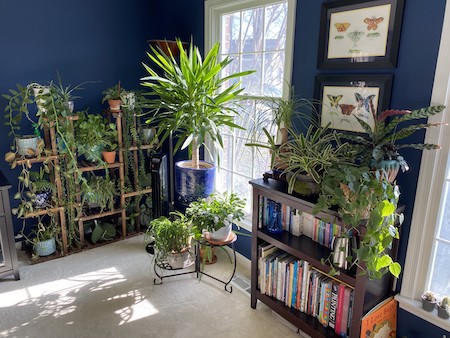 Picture a quiet room filled with light, and a variety of plants artfully configured in tasteful containers, that conveys a feeling of woodland peace and contentment. In ages past, this kind of room would have been called a conservatory, a solarium or a sunroom. But now we refer to it as an indoor garden or a Green Room. The Green Room allows today’s gardeners to create a lush garden space in the home to enjoy all year. To distinguish what a Green Room is and is not, several house plants sitting on a windowsill does not qualify as a Green Room. And it is not a group of containerized garden plants brought indoors to over winter.
Picture a quiet room filled with light, and a variety of plants artfully configured in tasteful containers, that conveys a feeling of woodland peace and contentment. In ages past, this kind of room would have been called a conservatory, a solarium or a sunroom. But now we refer to it as an indoor garden or a Green Room. The Green Room allows today’s gardeners to create a lush garden space in the home to enjoy all year. To distinguish what a Green Room is and is not, several house plants sitting on a windowsill does not qualify as a Green Room. And it is not a group of containerized garden plants brought indoors to over winter.
Instead, a Green Room is a permanent installation of many different plants that are carefully curated to provide year-round enjoyment indoors. It provides an escape from a busy world where we spend 90 percent of our lives indoors. The abundant sunlight, oxygenation, air purification and stress reduction benefits are more than enough to justify its existence alone.
The installation of a Green Room is planned as carefully as any outdoor garden project, with careful consideration given to all the factors needed for it to thrive in an interior environment. To begin, the Green Room has five factors that are essential to its success: light, temperature, humidity, water and nutrition. Then planning can begin to address soil, containers, plant selection, maintenance and pest control. The following sections provide detail on each topic, making it easy to build your own Green Room.
Light
Choose a space filled with natural light from large windows or possibly a glass wall to allow for ample sun exposure. Guidelines suggest the space needs at least four hours of direct sunlight. Don’t forget that grow lights can be used to supplement windowless or shady spaces.
Temperature
Guidelines suggest the space have controlled temperatures from 65 degrees during the day to 50 degrees during the night. Depending on the choice of plants, especially if you intend to include some tropical species, some spaces may need slightly higher temperatures with 75 degrees during the day and 65 degrees at night.
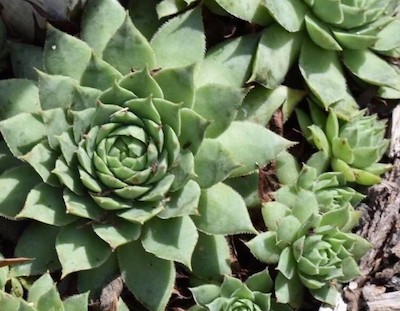
Succulent ‘Sempervivum tectorum’
Humidity
A Green Room needs an average humidity of 25 percent to 49 percent with consideration for tropical plants which may need 50 percent. A humidity meter helps keep track of the current status and should be a part of the indoor garden tool kit.
Water
Generally, Green Room plants are hand watered from a watering can or hose so there is no need for a sprinkler system. Indoor gardeners also make good use of a plastic misting bottle which can be stored in a corner or on a shelf to hydrate plants as often as needed. Thoughtful guidelines for watering apply to keep the plants from being overwatered. The surface of the plant should be dry before re-watering. Use the “pinkie” test to determine when to soak the plant by inserting a pinkie finger into the soil and measuring where the soil begins to dry out. If it is moist to the first inch of the finger, there’s no need to water until the soil dries out a little more. Avoid overwatering by establishing a regular watering schedule, such as if it is Tuesday, water.
Nutrition
As with water, many gardeners are tempted to give their plants too much food. The danger of giving an indoor plant too much fertilizer comes from the formation of salts in the soil water. If over fertilized, the water become so salty it burns the plant’s roots while removing water from them. The telltale sign of too much fertilizer is the white crust on the surface of the soil and a film near the rim of the container. Generally, new plants do not need fertilizer until they begin to grow. Without growth, the plant doesn’t need fertilizer.
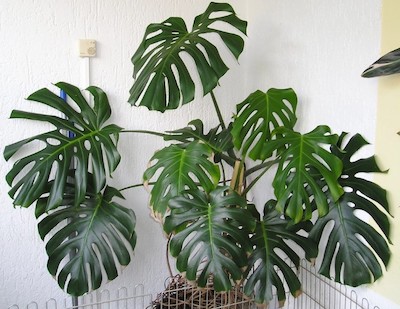
Monstera deliciosa
Soil
Soil selection is extremely important for two reasons. First, containerized plants need specialized potting soil to support adequate drainage from the pots. This is not a place where a bucket of ordinary garden soil will work. Most potting soils contain sphagnum, vermiculite and perlite which make an ideal blend for indoor plants. The second reason is that different plants need different kinds of soil, particularly succulents and tropical plants that need a type of media composed of different kinds of bark. Consult with a specialist at a garden center to make sure the soil selection is correct.
Containers
Containers contribute to the aesthetic beauty of the indoor garden and unify the style of the different types of plants. Choose containers that are compatible in shape and materials to address the artistic quality of the collection. Most experts recommend terra cotta planters for Green Rooms, with holes for drainage with matching companion saucers. The holes allow water to pass through the soil to keep the plant roots from becoming waterlogged, and the saucers hold the water to be reabsorbed through the roots. (Be sure to add a layer of rocks to hold the container bottom away from the water in the saucer.) Other materials can be used for containers but will influence water absorption. Containers made from synthetic materials such as polyethylene, polyurethane, plastic and fiberglass are lightweight when compared to terra cotta pots. They are easily moved from place to place and chip resistant. Water evaporation rates are lower in this type of container as compared to clay containers meaning they do not dry out as quickly and introduce the challenge of overwatering. A final consideration of choosing containers is size. It is always wise to buy a large pot to allow room for growth so the plant can live in the same location for several years before it is necessary to repot.
Plant Selection
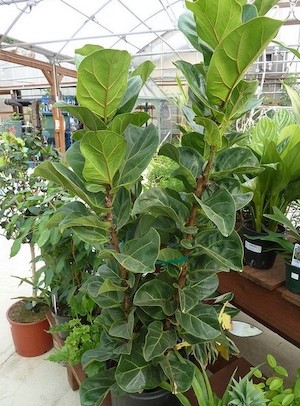
Fiddle-leaf Fig, Ficus lyrata
Without a doubt, plant selection is the most satisfying part of establishing a Green Room. The possibilities are endless and garden centers have extensive varieties to make selection difficult. The basic rule of thumb is to select a good variety, but make sure all the selected plants have similar environmental requirements for light, water, humidity and nutrition. Create variety through choosing some small, large, flowering, foliage, ferns and citrus plants. Ask a specialist at the garden center to help you make sure the plants are compatible and keep the tags from the plants for easy reference later. Select plants that appear to be pest free, sturdy, clean and well potted. Look for healthy foliage, new growth, new flowers and leaf buds.
Suggestions
Tropical Foliage: Split-leaf philodendron (Monstera deliciosa), Bird of Paradise (Strelitzia reginae), Fiddle Leaf Fig (Ficus lyrata). Remember that tropical foliage can be light sensitive and may not do well in a bright light environment.
Succulents and Cacti
Aloe Vera, Echeveria, Haworthia, Sempervivum
Ferns: Boston Fern (Nephrolepis exaltata), Maidenhair Fern (Adiantum), Staghorn Fern (Platycerium)
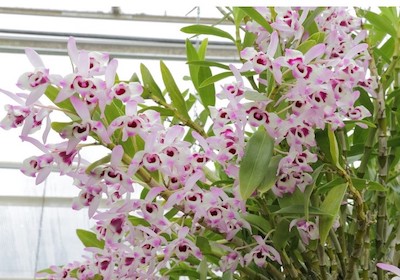
Dendrobium Orchids
Orchids
Phalaenopsis, Cymbidium, Dendrobium
Citrus Trees
Dwarf Lemon (Citrus limon), Calamondin Orange (Citrofortunella macrocarpa)
A Green Room demands keeping plants clean and neat to maintain them as a part of its beauty and charm. This also prevents disease and insect infestation. Deadhead old flowers, old leaves and dried branches. Keep plants dust free by washing them with warm water and mild soap, covering the soil to prevent the soap from entering the soil. Prune when necessary, with sharp, clean scissors. Refer to gardening manuals to address specific maintenance for each kind of plant.
Under the best circumstances, indoor gardens can become a haven for pests. The most common are Scale Insects, Mealybugs, Aphids, Spider Mites and Thrips, all of which are extremely deadly. Scale insects can be particularly destructive and almost invisible until they have caused considerable damage. Mealybugs cause similar damage as Scale from the insects’ excretion of honeydew with the eventual attraction of fungal disease called Sooty Mold. Aphids reside on new growth and suck juices causing deformed leaves, buds and flowers. They also excrete honeydew and attract Sooty Mold. Spider Mites are a very common plant pest, almost invisible, but identified by the resulting leaf damage that looks like webbing. Unlike the others, they can be combated with a spray of soapy water. Thrips also suck sap and cell content causing injured tissue and dead cells. Given the close confines of the plants, often the best remedy is to remove and destroy the affected plants and start over.
Even if your Green Room starts just as a Green Corner, you can still enjoy the many benefits to your well being that come from having an indoor garden. Through careful space planning, selection of plants and thoughtful maintenance, you can create a thriving oasis that enriches both your living space and your life.
References
• Indoor Plant Culture, Diane Relf, Elizabeth Ball, and Alex Niemiera,
Virginia Cooperative Extension
• Indoor Gardens, University of Florida, Institute of Food and Agricultural Sciences (IFAS)
• Growing Indoor Gardens with Success, Bodie V. Pennisi, Bulletin 1318, University of Georgia
Extension